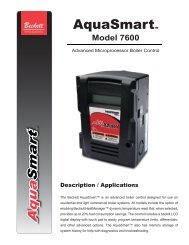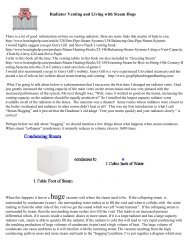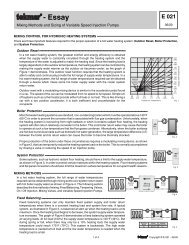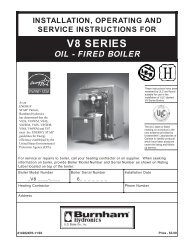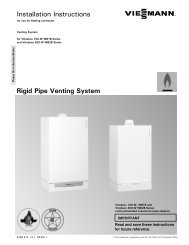Steam Locomotive Firebox Explosion on the Gettysburg Railroad ...
Steam Locomotive Firebox Explosion on the Gettysburg Railroad ...
Steam Locomotive Firebox Explosion on the Gettysburg Railroad ...
You also want an ePaper? Increase the reach of your titles
YUMPU automatically turns print PDFs into web optimized ePapers that Google loves.
eturned from repair. While it is not known<br />
how much water was leaking from <strong>the</strong> valve,<br />
it was enough water to necessitate clearing<br />
half an open-decked observati<strong>on</strong> car when<br />
<strong>the</strong> locomotive was pulling in reverse. If<br />
nothing else, <strong>the</strong> leak reduced <strong>the</strong> efficacy of<br />
water delivery to <strong>the</strong> boiler. It should also be<br />
noted that had <strong>the</strong> accident locomotive been<br />
equipped with a feed-pump gage, <strong>the</strong> gage<br />
would not have provided an accurate pressure<br />
indicati<strong>on</strong>, since it would have been<br />
c<strong>on</strong>nected between <strong>the</strong> feed pump and <strong>the</strong><br />
leaking check valve, which was relieving<br />
pressure.<br />
The leaking of <strong>the</strong> check valve indirectly<br />
c<strong>on</strong>tributed to <strong>the</strong> lack of water in <strong>the</strong> boiler.<br />
Because <strong>the</strong> valve leaked, <strong>the</strong> feed pump<br />
was shut down, cutting off <strong>the</strong> water supply<br />
to <strong>the</strong> boiler and c<strong>on</strong>tributing to <strong>the</strong> cause of<br />
<strong>the</strong> crownsheet failure.<br />
Injector--The o<strong>the</strong>r means of water delivery<br />
to <strong>the</strong> boiler was <strong>the</strong> injector, which<br />
was not used, according to <strong>the</strong> locomotive<br />
crew. Postaccident examinati<strong>on</strong> of <strong>the</strong> injector<br />
showed that it had <strong>the</strong> wr<strong>on</strong>g type of<br />
steam valve disk. Such a disk would make it<br />
difficult to prime <strong>the</strong> injector, and if a lifting<br />
injector cannot be primed, it will not operate<br />
correctly. It would be possible for <strong>the</strong><br />
injector to functi<strong>on</strong>, but <strong>on</strong>ly with some<br />
difficulty. Although <strong>the</strong> injector does not<br />
appear to have been involved in <strong>the</strong> crownsheet<br />
failure, it is typical of ano<strong>the</strong>r device<br />
<strong>on</strong> locomotive 1278 that ei<strong>the</strong>r did not<br />
functi<strong>on</strong> or functi<strong>on</strong>ed marginally. The<br />
Safety Board c<strong>on</strong>cludes that because <strong>the</strong><br />
wr<strong>on</strong>g type of disk had been installed in <strong>the</strong><br />
injector, it would have been difficult to use<br />
<strong>the</strong> injector to add water to <strong>the</strong> boiler.<br />
Water-Glass and Gage-Cock Testing--During<br />
<strong>the</strong> testim<strong>on</strong>y, both accident firemen, <strong>the</strong><br />
helper engineer (who also worked as a<br />
steam-locomotive engineer), <strong>the</strong> helper fireman,<br />
ano<strong>the</strong>r <strong>Gettysburg</strong> Passenger Services<br />
employee (who was qualified as both a<br />
steam-locomotive fireman and an engineer),<br />
and <strong>the</strong> owner of <strong>Gettysburg</strong> <strong>Railroad</strong> each<br />
described and dem<strong>on</strong>strated how he would<br />
blow down and verify <strong>the</strong> water glass. Only<br />
<strong>the</strong> owner of <strong>Gettysburg</strong> <strong>Railroad</strong>, <strong>the</strong><br />
engineer’s fa<strong>the</strong>r, dem<strong>on</strong>strated <strong>the</strong> correct<br />
method of blowing down. All <strong>the</strong> <strong>Gettysburg</strong><br />
Passenger Services employees had been<br />
taught by <strong>the</strong> engineer. No <strong>on</strong>e said that he<br />
also tested <strong>the</strong> gage cocks when he blew<br />
down <strong>the</strong> water glass, as required by<br />
regulati<strong>on</strong>. The Safety Board <strong>the</strong>refore<br />
c<strong>on</strong>cludes that <strong>the</strong> firemen did not know,<br />
because <strong>the</strong>y had not been properly taught,<br />
how to blow down <strong>the</strong> water glass or test <strong>the</strong><br />
gage cocks. The lack of knowledge about<br />
such basic procedures reflects <strong>the</strong> lack of an<br />
effective training program at <strong>Gettysburg</strong><br />
Passenger Services.<br />
Delineati<strong>on</strong> of Resp<strong>on</strong>sibilities--According<br />
to <strong>the</strong> testim<strong>on</strong>y of <strong>the</strong> two firemen, resp<strong>on</strong>sibility<br />
was not clearly divided am<strong>on</strong>g<br />
<strong>the</strong> members of <strong>the</strong> crew, particularly between<br />
<strong>the</strong> two firemen. Each fireman felt he<br />
had a firm grasp of <strong>the</strong> tasks that needed to<br />
be d<strong>on</strong>e and how to do <strong>the</strong>m; however,<br />
nei<strong>the</strong>r was totally aware of who was<br />
resp<strong>on</strong>sible for what tasks. The situati<strong>on</strong> is<br />
much <strong>the</strong> same as <strong>the</strong> <strong>on</strong>e in which two<br />
baseball outfielders run toward a fly ball.<br />
Each may know how to catch <strong>the</strong> ball, but<br />
unless <strong>the</strong>re is a clear understanding of<br />
resp<strong>on</strong>sibility, each may expect <strong>the</strong> o<strong>the</strong>r to<br />
catch <strong>the</strong> ball, and <strong>the</strong> ball may fall to <strong>the</strong><br />
ground. Or each may attempt to catch <strong>the</strong><br />
ball, resulting in a collisi<strong>on</strong> and <strong>the</strong> ball’s<br />
being dropped. In ei<strong>the</strong>r case, delineati<strong>on</strong> of<br />
resp<strong>on</strong>sibility is critical. In this case, instead<br />
of a ball, <strong>the</strong> critical item “dropped” was <strong>the</strong><br />
feed pump. The Safety Board c<strong>on</strong>cludes that<br />
<strong>the</strong>re was no clear divisi<strong>on</strong> of resp<strong>on</strong>sibility<br />
44



